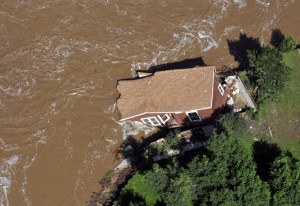Contaminated water spilling from flooded oil and gas drilling sites in Colorado is refocusing attention on the environmental risks surrounding America’s fracking boom.

Floods that have devastated north-central Colorado, killing eight people and displacing thousands, have also dislodged storage tanks that hold drilling wastewater left over from the production process known as hydraulic fracturing, or fracking.
While the impact of leaks is yet to be assessed, environmental groups, which oppose fracking, are expressing concerns about the risk of adding drilling fluids to other toxins potentially loosed by the floods.
Fertilizer and pesticides running from vast tracts of farmland may pose a bigger threat. But fracking waste is one of the newest problems in a state where energy production is on the rise, and spills could pose the latest environmental challenge to the multibillion-dollar oil and gas industry.
“We don’t know the disposition of the chemicals and waste at this point, but there’s a possibility that the flooding allowed their release, and that is a major concern,” said Tony Ingraffea, professor of engineering at Cornell University in Ithaca, N.Y.
“We could have a long-term, hazardous waste cleanup problem.”
A helicopter flight on Tuesday over Weld County in Colorado, one of the worst affected areas and home to about 20,000 active oil and gas wells, afforded views of listing and toppled storage tanks at oil and gas wells. Some sites were submerged under brown floodwater; cattle grazed on higher ground nearby.
Encana Corp, a major driller in the state, said flooding had dislodged some storage tanks holding wastewater at oil and gas wells, and a “small amount” of oil had spilled from one well. The spill was contained at the site, a spokesman said.
Nearly 2,000 oil and gas wells have been shut in the region, according to the Colorado Oil and Gas Association.
Fracking involves pumping millions of gallons of water, sand and chemicals underground to fracture shale rock and release oil or gas. Much of that water returns to the surface and is stored in lined pits or closed tanks for recycling or injection in underground storage caverns offsite.
Environmental groups say fracking can contaminate water supplies.
The fracking fluid used in Encana’s Weld County wells contains a long list of chemicals, including hydrochloric acid and benzyl chloride, according to Frac Focus, a website where energy firms can disclose substances they are using to frack.
As in much of the United States, where a drilling boom is underway, fracking activity has increased in Colorado over the past decade. In June this year, oil production rose nearly 30 percent above the same period in 2012, to 161,000 barrels of oil each day.
Potential Impact For Drillers
Precedents in North Dakota, one of the centers of the U.S. fracking boom, point to how drillers may have to adjust to flood risks in Colorado.
Floods from thawing snow along the Missouri River in North Dakota in 2010 and 2011 washed fracking fluids, drilling mud and brine into nearby streams, prompting changes in the laws governing storage of wastewater in the state.
In April 2011, floods swamped a Hess Corp open pit whose contents eventually spilled into the nearby McLoed Lake. Later that year, oil from a Ryan Exploration well site spilled into the Missouri River due to summer floods.
Hess subsequently paid $114,000 in fines, spokesman Jon Pepper said the company also began using closed-loop systems, which use steel or fiberglass tanks to store contaminated wastewater and do not require open pits for storage.
Early last year, the North Dakota Industrial Commission amended its rules to prohibit the use of open pits except in cases of emergencies. Companies can still store drilling waste in open pits for up to 72 hours after drilling a well or after securing approval from the industrial commission.
Assessing The Damage
Open pits, which can contain about 200-400 barrels of liquid(8,400-16,800 gallons) are allowed in Colorado, though companies generally do not rely on them to store contaminated fluids.
Andarko Petroleum, which shut 675 wells and 20 miles of pipelines after the flood, said it does not have any open pits in the state.
Encana, which initially shut nearly 400 wells after the flood, said it too used a closed loop system in Colorado.
Still, concerns remain even about closed storage units that have been toppled by the rains and may be leaking.
Todd Hartman, spokesman at the Colorado Department of Natural Resources, said it was rare for open pits to be used in that part of the state and that most flowback water was placed in closed tanks.
“We are assessing the impact to open pits, including building a count of how many pits may have been affected,” Hartman said.
Some have played down the potential impact of spilled drilling fluids, saying the flood should dissolve harmful chemicals in waste pits before storm water reaches an underground aquifer or clean water source. Experts said bacteria may degrade any chemicals that do not dissolve in water.
“The amount of wastewater is so small compared to the amount of water passing through there, and compared to the chemicals used in farming,” said Robert Watson, a professor of petroleum and natural gas engineering at Pennsylvania State University.
(AP Photo/The Greeley Tribune, Joshua Polson)





















 Why Insurance Telematics Integrations Fail
Why Insurance Telematics Integrations Fail  How One MGU Grew Fivefold When Capacity Fled Cat-Prone Property Markets
How One MGU Grew Fivefold When Capacity Fled Cat-Prone Property Markets  U.S. E&S Outlook No Longer Positive: AM Best
U.S. E&S Outlook No Longer Positive: AM Best  The Future of Knowledge in Insurance: From Training to AI-Powered Productivity
The Future of Knowledge in Insurance: From Training to AI-Powered Productivity 






